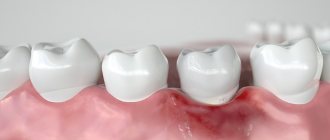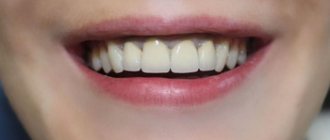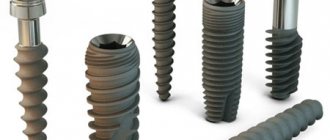White plaque on the gums can be a symptom of candidiasis, a disease caused by a fungus of the genus Candida. Under the influence of a fungal infection, stomatitis develops. First, multiple cheesy white rashes appear on the surface of the cheeks, tongue, palate and gums. Gradually they begin to grow. As the lesions grow, they merge and a film forms in the mouth.
At the beginning of the disease, plaque can be scraped off. But in the place where it was removed, small ulcers remain. When the disease is advanced, the whitish film can no longer be scraped off. The patient feels serious discomfort. Dryness, burning, pain, and a metallic taste appear in the mouth. In the advanced stage there are systemic symptoms. The head begins to hurt, the patient complains of lethargy and weakness, and the temperature rises.
Candida is an opportunistic microflora. They live in the oral cavity of any person. As long as their number is within normal limits, pathological conditions do not develop. If candida begins to multiply quickly, they provoke candidiasis.
Causes
- Weakened immunity. In people with weak immunity, the body's resistance decreases. Candida begins to multiply quickly.
- Hormonal imbalances. Changes in hormonal levels lead to various pathologies, and candidiasis is one of them.
- Pathologies of the gastrointestinal tract.
- Diabetes.
- Long-term use of antibiotics. These drugs disrupt the normal microflora. They kill not only pathogenic microorganisms, but also beneficial bacteria.
- Dental diseases. Candidiasis can be provoked by caries and inflammation in the oral cavity.
- Poor oral hygiene. Patients who do not pay proper attention to hygiene are more susceptible to white plaque.
- Dentures. An incorrectly selected denture puts pressure on the mucous membrane, causing it to rub. In these places, the color changes and the tissue structure is disrupted.
- Damage to the mucous membrane. It performs a protective function. Damage provokes various dental pathologies.
White plaque in the mouth is a sign of more than just candidiasis. It also accompanies other pathological conditions:
- Tooth cyst. This is a protective neoplasm that forms in response to the inflammatory process. When pathological cells die, a cavity with dense walls is formed around the necrosis zone, inside which there is liquid.
- Leukoplakia. This is a dense white growth on the gums and cheeks. Without treatment it leads to keratinization.
- Oncological diseases in the initial stage.
Sometimes a problem arises as a response to external irritation. For example, after brushing or whitening your teeth. In this case, it goes away on its own after some time.
Dentistry for those who love to smile
+7
Make an appointment
Average cost of treatment in Moscow
| Name of service | Cost, rub. |
| Dentist consultation | 600 |
| Periodontist consultation | 740 |
| Consultation with an implantologist | 820 |
| Treatment of complications | |
| Removing dental plaque in the area of 1 tooth | 180 |
| Periodontal applications in the area of 1 tooth | 370 |
| Application of a protective periodontal bandage | 400 |
| Closed curettage of periodontal pockets | 900 |
| Open curettage of pockets | 1300 |
| Flap surgery | 3000 |
| Implant removal | 6900 |
| Implantation of osteoconductive material in the area of 1 tooth | 10900 |
| Implantation of a protective membrane (1 tooth) | 12900 |
Treatment
The treatment program is selected depending on what causes the white plaque on the gums:
- Antifungal drugs. Prescribed if the disease is caused by candida.
- Treatment of the oral cavity with antiseptics. To do this, you can use hydrogen peroxide, chlorhexidine, miramistin, and potassium permanganate solution. Apply the product to a sponge and gently apply it to the affected areas.
- Special toothpastes. The doctor will recommend the use of special pastes that contain the enzymes lactoferrin, lactoperoxidase, and lysozyme. They are necessary in order to restore the microflora.
- Therapy aimed at restoring the immune system. The specialist will recommend medications, vitamins, and a special diet.
Are white spots on the gums a symptom of rejection?
The following signs indicate the initial stage of rejection:
- pain around the operated area;
- edematous hyperemic mucosa;
- bleeding;
- bad breath.
As the destructive process progresses, the symptoms increase and include:
- pin mobility;
- severe pain syndrome;
- pronounced hyperplastic changes in the gingival contour;
- periodontal pockets;
- fistulous tracts, the purulent contents of which come to the surface through the resulting white sac.
The associated infection is manifested by an increase in body temperature, intoxication, and deterioration of the general condition. Typically, patients with implant failure have regional lymphadenitis.
The appearance of white dots at the site of the implanted titanium root may indicate a purulent process and the presence of fistula tracts , which are signs of rejection.
Why an implant may not take root after installation
- Unprofessionalism or mistake of the implantologist . Lack of experience, inattention, and negligence can lead to serious consequences.
- Poor quality implantation system . Working with direct suppliers allows clinics to avoid purchasing low-quality counterfeits. Small private dentistry does not always have this opportunity, so there is no confidence in the originality of the designs. In addition, high-quality materials are required for manufacturing - the implant cannot be cheap.
- Failure to comply with doctor's recommendations . Any work of a specialist can be reduced to zero by the patient’s incorrect actions during the engraftment period. Deteriorating health also negatively affects implants—rejection can occur even several years after surgery.
What to do to prevent the appearance of white plaque after implantation
You can minimize the risk of white spots and the development of peri-implantitis by following the recommendations of your implantologist.
- Avoid solid food for the first three days after surgery.
- No smoking.
- Massage your gums regularly. This will relieve swelling and improve blood circulation.
- Drink more water.
- Brush your teeth with a soft-bristled brush and children's toothpaste. Do not touch the seam area. Use an irrigator or floss.
- Carefully remove plaque on the gums with a cotton swab.
- Take all prescribed medications and perform the necessary procedures.
How to save an implant during rejection
Correct treatment tactics can stop inflammation within 10-14 days. In case of rejection due to medical error, qualified reimplantation will help. Failure to properly care for the operated area gives an unfavorable prognosis. Reimplantation is not relevant here.
Treatment consists of two stages:
- Medication course. Eliminates the inflammatory process. It is possible to modify the superstructure to redistribute the load on the implant.
- Surgical curettage of the source of infection. Ends with a course of antibiotics and antiseptic rinses.
Timely consultation with a doctor allows you to save the implant. In advanced cases, when treatment does not make sense, the implant is removed. A repeated implantation procedure is possible in a month or two, no later, since in the absence of load on the tissues, their recession begins.
Diagnostics
Only a doctor can determine the causes of white spots on the gums. The patient needs to talk about his feelings and events that preceded the appearance of this formation. Doctors usually visually identify the disease. But to clarify the diagnosis, you may need:
- blood analysis;
- X-ray.
The appearance of white spots on the oral mucosa may not necessarily indicate a dental disease. The patient should visit an otolaryngologist to exclude or confirm an ENT disease.
What is a white coating on a wound?
Two to three hours after extraction of the problem unit, a dark clot of blue, black or red color forms in the alveolar socket. This is a bloody secretion that forms the primary barrier to protect the socket from external elements and pathogenic bacteria. After several days, a coating appears on the surface of the clot - with a characteristic yellow, white or gray tint, externally resembling suppuration, and having a specific odor. However, this is not actually pus, but a special protein-based compound known in dentistry as fibrin.
The structure of the plaque can vary from soft to very dense. Preserving the integrity of the film allows for the development of natural processes beneath its surface:
- Gradual resorption of the blood clot:
- Reducing the diameter of the alveolar socket;
- Displacement of new cells - osteoblasts - to the central part;
- Closing the wound with regenerating gum tissue.
The formation of fibrinous plaque is a necessary process, important from the point of view of restoration of the body in the period after tooth extraction.
Cyst
This phenomenon is not always noticeable on the surface, but sometimes you can notice white spots on the teeth near the gums. A cyst is a formation in soft tissue. This is a cavity inside the gum, in the walls of which there are modified cells.
Usually there is pus in this cavity. A dental cyst occurs due to infection of soft tissues, as well as due to their pathological growths.
Poor nutrition
Another reason for the appearance of white spots on the gums is considered to be a violation of the diet. Vitamin C deficiency can manifest itself in different ways, negatively affecting different organs, including the gums. Microcracks may appear on them, into which bacteria penetrate and lead to inflammation.
Nutrition should strengthen the immune system in order to accelerate regeneration in the body. The menu should consist of:
- cheese;
- cottage cheese;
- garlic;
- young beef;
- spinach;
- fish;
- fermented milk products.
How to treat gum disease
An accurate diagnosis and treatment plan can be made after a complete examination of the oral cavity. The dentist determines the cause of inflammation, removes or treats teeth under anesthesia , performs professional dental cleaning and remineralization, and, if necessary, prescribes antibiotics or antiseptic drugs. Minsk Center for Family Dentistry performs all procedures under medical sedation. This allows you to treat your teeth efficiently and quickly. Sedation increases the pain threshold, reduces salivation, allows the patient to relax and stop being afraid. This technology is suitable for both adults and children.
In addition to dental treatment, special attention should be paid to diet. It should include fish, fresh herbs and vegetables, dairy products (especially cottage cheese, milk, cheeses), as well as meat, eggs and fruits. Food should not be constantly liquid and soft - it will be useful to occasionally nibble on a carrot or a piece of apple.
Maintaining oral health and protecting teeth from decay is not difficult, the main thing is to follow the doctor’s basic recommendations, eat right and take care of hygiene. The beauty of a smile is in your hands!
Candidiasis
If a white spot under the gum is easily removed with a cotton swab, but appears again after a while, then this is considered a sign of candidiasis. Candidiasis or thrush is a lesion of the mucous membrane by Candida fungi.
Fungal microorganisms of this kind are present in the normal microflora of the mouth, so the disease does not appear when they penetrate the mucous membrane, but when they multiply intensively. This is usually observed with reduced immunity or dysbacteriosis. Pathological proliferation of fungi is associated with:
- vitamin deficiency;
- decreased immunity due to severe illnesses, especially infectious ones;
- lack of iron;
- dysfunction of the endocrine system;
- dysbacteriosis of the oral cavity.
Candidiasis develops with a decrease in salivation and an increase in the acidity of saliva (this condition is noticed in many gastrointestinal ailments). This disease requires treatment to prevent complications.
What can you do at home?
Treatment can be performed at home, but only after consultation with a doctor. The patient receives a regimen to follow. What can you do before visiting a doctor? There are several recommendations that make the situation easier:
- Whatever the reason for the appearance of white spots, rinsing with an antiseptic solution will improve the condition. It is sold in pharmacies - “Chlorhexidine”, “Furacilin Eludril”, “Etonium”. But you can cook everything yourself. Add salt or soda (1 tsp) to warm water (1 glass). Everything gets mixed up. Rinse procedures can be performed every 2 hours. These measures stop the action of pathological microflora, reduce swelling, itching, and pain.
- You can make an infusion of beneficial herbs. Plants with anti-inflammatory, antiseptic, regenerating effects are needed. Sage, chamomile, calendula, and oak bark are suitable for this. The plants are suitable for brewing either separately or together. To prepare a healing solution, you need crushed herbs (2 tablespoons), which are poured with boiling water. The product is infused for several hours, after which it can be filtered and used for rinsing.
- Propolis has a powerful antibacterial and regenerating effect. For diseases of the mucous membrane, it is allowed to be taken. You can buy the tincture ready-made or make it yourself. To do this, 20 g of the product should be filled with alcohol (70%). After 3 days the product will be ready. Store it for a long time in the refrigerator. To prepare a solution for rinsing, you need to add the prepared tincture (2 tsp) to water (1 glass). The procedure is performed at least 5 times a day.
Experts believe that if white spots on the gums do not disappear on their own within a few days, then you should not self-medicate. Especially if other unpleasant phenomena occur with these symptoms.
Leukoplakia
If in adults the white spots on the gums are dense, have a milky tint, or are presented in the form of a cluster of small scales, then this is a sign of oral leukoplakia. It is not considered an independent disease; it is a syndrome in which thickening and keratinization of the epithelium of the mucous membrane occurs.
Leukoplakia appears as a reaction to aggressive factors:
- trauma to the mucous membrane from sharp teeth or poorly installed dentures;
- frequent long-term consumption of hot or spicy foods;
- smoking;
- prolonged exposure to harmful chemical components.
This syndrome also appears with a deficiency of vitamin A. The danger of leukoplakia is that it can turn into cancer if left untreated. The first sign of a malignant tumor is a graying and clouding of the white spot.
Herpes infection
Many people have the herpes virus; often it does not manifest itself throughout life. It often affects children 3-5 years old. Herpes can be in acute and chronic form. The reasons for its occurrence are associated with poor hygiene and close contact with the carrier. In adults, the disease appears from stress, colds, weak immunity, and sudden changes in weather conditions.
Herpes infection manifests itself in the form of a small rash of white blisters, which can merge into a common lesion. It is not dangerous to humans and often disappears without any treatment. It should be borne in mind that after a single appearance, herpes can occur again, and usually in the same place.
At the first symptoms, you need to take medications, for example, Acyclovir. Herpes is often confused with stomatitis. But it affects the gums, and stomatitis begins to appear on the inside of the cheeks.
Poor quality care
Often whitish, yellowish spots on the gums occur due to poor oral care. They are considered normal plaque, which is not a pathological process. Due to the accumulated and multiplied pathogenic microorganisms, the healthy microflora of the oral cavity is disrupted.
It is necessary to rinse with medicinal plants or a warm soda solution after meals. It is important to brush your teeth regularly. If plaque builds up, it is necessary to use antibacterial rinses several times a day after meals. This restores a healthy environment in the mouth and protects against stains without medications or additional procedures.
First aid
If your gums are inflamed , but you can’t get to the dentist in the near future (for example, you went to the country where there are no dental clinics, and the nearest train is only tomorrow), use a soda solution. Dissolve 1 teaspoon of baking soda in a glass of water. It is necessary to rinse your mouth every half hour - this will help temporarily relieve symptoms. If you have sage, chamomile, or maybe oak bark, you can rinse your mouth with an infusion based on these herbs. Do not take antibiotics under any circumstances, only painkillers if necessary!










